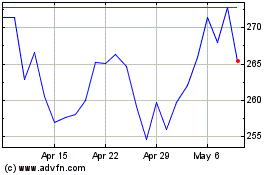Market Is Ignoring Risks to Telecom - Heard on the Street
June 06 2017 - 1:18PM
Dow Jones News
By Miriam Gottfried
Telecom stocks have shown some signs of life recently after
suffering amid a brutal price war. This isn't the time for
optimism.
The partnership between Comcast and Charter Communications
announced last month gives the cable operators a better chance to
succeed in the wireless business by giving them scale in
technology, procurement, logistics and billing. Investors should
take the risk to wireless carriers more seriously. Shares of
AT&T, Verizon, T-Mobile US and Sprint are either flat or up
since the deal's announcement.
Comcast is already selling wireless service and Charter is set
to launch its own in 2018, both of which will run on Verizon
Communications' network. Together, the two will be able to market
to roughly 97% of the U.S. wireless market, UBS estimates. Even
though they are only selling to their existing video and broadband
customers, their low pricing could help them attract a meaningful
subscriber base.
In addition to a per-gigabyte plan, Comcast offers unlimited
wireless service for $45 a month per line to households that buy
its top X1 video package, of which there are currently 2.9 million.
At one line, that represents a 50% discount to AT&T and is
cheaper than all four major wireless carriers. The cable company
also offers a $65 a month per line unlimited service to any of its
Xfinity internet customers, a 28% discount versus AT&T for a
single line.
Assuming Comcast attracts about 5% of the subscribers on the
best X1 package and about 2% of other subscribers, it would get
about 1.5 million wireless subscribers by the end of 2018, UBS
projects. Combine that with the bank's expectations for Charter,
and cable should have more than two million wireless subscribers by
the end of next year, climbing to six million by the end of
2020.
For U.S. wireless carriers, that might seem like a manageable
risk. Six million people is only 3% of the U.S. wireless market.
But that more than accounts for the industry's annual growth. Cable
could accelerate subscriber losses at AT&T and Verizon and
could curb growth at T-Mobile and Sprint.
Between the two giants, AT&T would feel more pain because
the impact on Verizon would be offset by the high-margin fees
Comcast and Charter pay for the use of its network. Every 500,000
cable subscribers adds $120 million to Verizon's annual earnings
before interest, taxes, depreciation and amortization, UBS
estimates.
The cable operators could fail to hit those subscriber estimates
if the technology, which also incorporates the cable companies'
Wi-Fi hot spots, proves unreliable. Cable lacks the extensive store
network of major wireless carriers, and Comcast doesn't yet allow
customers to bring their own devices. The economics of renting
airwaves could also curb cable's growth.
Until then, wireless investors should curb their enthusiasm.
Write to Miriam Gottfried at Miriam.Gottfried@wsj.com
(END) Dow Jones Newswires
June 06, 2017 13:03 ET (17:03 GMT)
Copyright (c) 2017 Dow Jones & Company, Inc.
Charter Communications (NASDAQ:CHTR)
Historical Stock Chart
From Mar 2024 to Apr 2024

Charter Communications (NASDAQ:CHTR)
Historical Stock Chart
From Apr 2023 to Apr 2024
